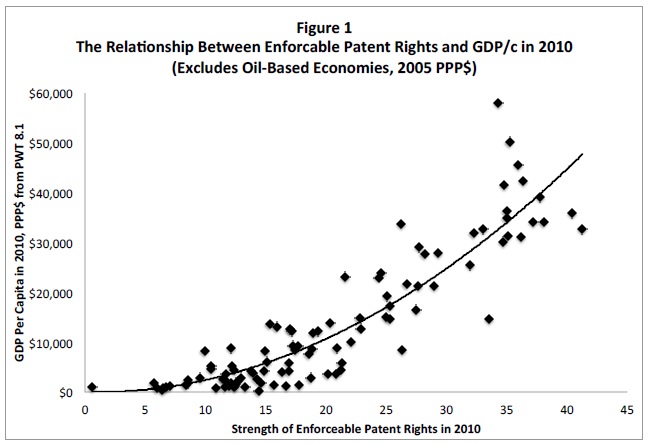The following post comes from Wade Cribbs, a 2L at Scalia Law and a Research Assistant at CPIP.
 By Wade Cribbs
By Wade Cribbs
Everyone in the technology industry knows that 5G is posed to revolutionize the world, but the finer points of 5G’s impact on the U.S. economy are detailed in a new report by Accenture entitled The Impact of 5G on the United States Economy. In the report, Accenture explains how 5G stands to add up to $1.5 trillion to the U.S. GDP and create or transform up to 16 million jobs from 2021 to 2025.
5G’s benefits include enabling the development of new industries, improving current industries, and accommodating the current, rapid growth of interconnected technologies. Autonomous vehicles are only achievable through 5G’s increased broadband, which can handle the large amount of data transferred to and from the sensors on vehicles on the road as they are operating. Furthermore, 5G is necessary to support the expected growth to 29.3 billion devices and 14.7 billion machine-to-machine connections by 2023. To get a better look at the specific impact 5G will have on the coming business and consumer landscape, Accenture focuses on five key business sectors: manufacturing, retail, healthcare, automotive and transportation, and utilities.
As 10,000 baby boomers retire a day, the manufacturing industry is in dire need of some way to meet its labor shortage. Due in part to a lack of interest from the younger generations, manufacturers are increasingly looking to automation. 5G will allow for an unprecedented level of control and synchronization across the warehouse floor. Examples of manufacturing improvements implementable with 5G include: AI assisted asset management utilizing video analytics and attached sensors; connected worker experiences implementing augmented reality to provide workers with a safer work experience and reduced training times; and enhanced quality monitoring through a combination of AI inspection and UHD video streaming monitoring. Accenture estimates that 5G will provide a $349.9 billion increase in sales for manufacturing of the equipment and products necessary to implement 5G in other business sectors.
In the retail sector, 5G can provide the data needed to support frictionless checkout experiences. AI used in combination with UHD video monitoring will allow for customers to be charged when putting items in their basket, eliminating the long lines that 86% of customers say have caused them to leave a store, which in turns leads to $37.7 billion in missed sales annually. Furthermore, this same AI monitoring system can be used to personalize a shopping experience through monitoring customers and alerting sales associates to a customer with a problem without the customer having to find and flag down an associate; the system can also monitor for theft, which costs the retail industry $25 million daily. Overall, Accenture estimates that the retail industry stands to see a $269.5 billion increase in sales due to 5G sales and cost savings.
Healthcare costs are expected to rise from $3.4 trillion to $6 trillion by 2027. As the need for healthcare professionals is expected to outstrip the labor supply, increases to technology and treatment efficiency are essential to address the problems presented by an aging population. The good news is that 5G is suited to address just these issues by eliminating waste, which is estimated to make up as much as 30% of spending. 5G will expand medical professionals’ ability to monitor patients, giving the option for at-home care to a wider range of patients as well as lowering the number of doctors required to monitor intensive care patients. Doctors will also be able to access previously unreachable patients for virtual consultations. No longer will rural Americans have to travel long distances to visit their doctor in the city. 5G will allow online consultants rapid access to vast amounts of data, such as MRI images, CAT scans, ultrasounds, ECGs, and stethoscope data. Accenture estimates that the healthcare industry stands to gain $192.3 billion in economic output and up to 1.7 million jobs.
As vehicles become smarter, safer, and more connected, 5G will enable automobiles to exchange data with other vehicles, the automotive infrastructure, and pedestrians. This will enhance vehicle safety, fleet management, and smart traffic management. The U.S. National Highway Traffic Safety Administration (NHTSA) estimates that the combined impact of vehicle-to-everything communication technology could reduce the severity of 80% of sober multi-vehicle crashes and 70% of crashes involving trucks. 5G video-based telematics will allow for automated vehicle fleets and fleet management capability, such as improved logistics security and goods-condition diagnostics to eliminate the up to 20% of empty cargo space in U.S. trucks. Through smart traffic managing by vehicle-to-vehicle communication and vehicle-to-infrastructure communication, traffic congestion, traffic accidents, and smog due to idling can all be reduced by an expected 15 to 30%. On the whole, Accenture estimates that $217.1 billion in revenue will be generated in the automotive and transportation industry by 5G.
5G will address multiple problems facing the utility industry, including vegetation and asset management, energy supply and resiliency, and next-generation workforces. 5G will allow smart grid technology to be implemented that can track and adapt to real-time disruptions to the power grid. In combination with smart grid technology, smart power plant technology will be able to map out peak power use and wear on equipment to determine optimal times for taking a machine offline for maintenance. Safer work environments can be created for the next generation workforce using augmented and virtual reality to train and eliminate manual methods with digital tools. Accenture estimates that the utility industry stands to grow by $36.9 billion in total sales from the implementation of 5G.
Accenture concludes that 5G is the necessary step towards achieving a new normal through AI, mass machine communications, and digital cloud technology. Every aspect of American life will be affected, and an unprecedented boost will be given to the economy.
To read the report, please click here.
 How did the world’s wealthiest nations grow rich? The answer, according to Professor Stephen Haber of Stanford University, is that “they had well-developed systems of private property.” In
How did the world’s wealthiest nations grow rich? The answer, according to Professor Stephen Haber of Stanford University, is that “they had well-developed systems of private property.” In 
